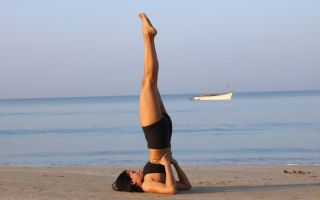Content
- 1 What is this exercise
- 2 What muscles work
- 3 The benefits of exercise birch
- 4 Is a birch tree useful for varicose veins and hemorrhoids?
- 5 Birch technique
- 6 Recommendations for the exercise
- 7 Possible difficulties and common mistakes
- 8 Contraindications for performing birch trees
- 9 How can you replace the exercise birch
- 10 Conclusion
In yoga, inverted postures are considered the most powerful in terms of effects on the body. The basic inverted asana is known here as Birch, and in yoga it is called Sarvagasana. What is the plan of this influence, what are the benefits and harms of the Berezka exercise, what therapeutic effect does it have and what contraindications it has.
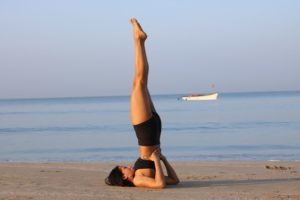
What is this exercise
Many people perceive it as a common position for stretching, without even knowing what valuable and useful properties Sarvangasana has.
India and Tibet are considered the birthplace of the shoulderstand, where it was used in the system of hatha yoga practice and its first name is Sarvangasana, or in translation from Sanskrit it is "posture of all parts of the body." In Europe it is customary to call it "candle", and in the Russian version it is the Berezka exercise, known from school.
It is believed that it is Berezka that is included in the preparatory programs for acrobatics, gymnastics, dancing, wrestling and other sports where the flexibility of the spine is important. In yoga, such a basic place of Sarvangasana is explained by its property of influencing the chakra system and exerting a wide range of effects on the organ systems of the body. She conquers with her accessibility and ease of implementation, and her regular practice can have a complex healing effect.
Exercise Birch consists in a stand on the shoulders, with straight legs extended upward. In the initial stages of performing a stand on the shoulder blades, a person supports the body with his hands in the lumbar and pelvis. However, after regular training, the arms can simply be stretched on the floor - the body will be able to be held in an upright position by strengthening muscle groups.
"Pose of all organs" got its name for a reason: during the exercise Birch, blood circulation in the body accelerates, blood flow to the occipital region through the vertebral artery improves, which in turn helps to optimize the work of all organ systems.
What muscles work
The benefit of the Birch exercise lies in its mechanism. When performing an asana, both large and small muscles of the body take part:
- muscles of the abdominals and lower back;
- gluteus maximus muscle;
- triceps and biceps;
- trapezius muscle.
Exercise Birch also has a useful property to work out the deep muscles of the cervical spine. By stretching them regularly, blood circulation in the head can be improved.
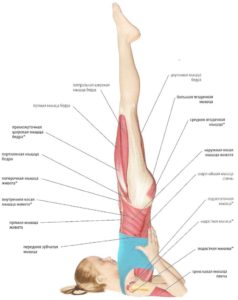
The benefits of exercise birch
What systems are affected by the "posture of all organs".
Despite all the simplicity of implementation, the Berezka exercise has a number of useful properties for our entire body:
- Enhancing brain function: due to increased blood flow through the vertebral artery to the back of the head, the stand is able to quickly normalize the brain, tidy up the nervous system and help return to normal. Birch is recommended for practice for children and adolescents: it helps to improve attention and develop memory.
- Cure for insomnia: By stimulating blood circulation in the brain, Birch can help get rid of insomnia in just a few sessions. For this, the exercise is recommended to be performed in the morning and in the evening, devoting 4 to 5 minutes every day.
- Prevention of heaviness in the legs: standing on the shoulder blades has a separate benefit for women who wear high heels. Exercise Birch can relieve fatigue and swelling of the legs, and is also a good prevention of varicose veins;
- Maintaining women's health: with the regulatory practice of Birch exercise in the female body, the production of necessary hormones improves, and critical days become less painful; during menopause, the benefits of standing is manifested in eliminating the harm of hot flashes, stress and tension.
- The birch tree helps to improve the flexibility of the spine and strengthen the upper muscles of the body and back, helps to acquire a flat stomach and an even posture.
- Reducing pressure on the abdominal cavity: Helps to improve the functioning of the pelvic organs, ensure good digestion and appetite, and relieve constipation and bowel disease.
- Prevention of prostatitis and hemorrhoids.
- Eliminate harmful toxins and prevent salt deposits.
- Relief from headaches and migraines.
- The rejuvenating property of Birch helps to maintain freshness of the skin of the face, making it smooth and elastic.
- Prevention of diseases of the thyroid and other endocrine glands.
- Strengthening the body's immunity.
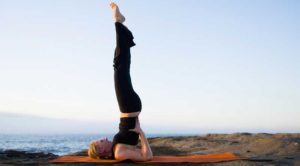
Is a birch tree useful for varicose veins and hemorrhoids?
Varicose veins are a disease due to which the veins in the legs expand, losing their elasticity. It occurs when special flaps in our blood vessels lose their ability to provide normal blood flow. They close instead of rising towards the heart. As a result, the blood stagnates in the veins, the pressure rises sharply, provoking vasodilation, which leads to the harm of blood clots.
When dealing with varicose veins, it is very important to avoid exercises that cause vasoconstriction. Stretching positions with raised legs are best suited, and Birch is the best option. All thanks to its useful property to improve the outflow of venous blood from the lower extremities of the body.
For this, it is very important to devote at least a few minutes a day to exercise. It is best done in the morning, for 3 to 5 minutes.
Hemorrhoids are characterized by swelling of the veins of the rectum, as well as painful inflammation. The swelling of the veins extends around the anus and just below the rectal area. There are many reasons for the occurrence of such a harmful phenomenon: a sedentary lifestyle, pregnancy, frequent diarrhea or constipation.
In addition to prevention, exercise Birch can be a useful tool in the treatment of this disease. It has a strong effect on the outflow of blood both from the lower extremities and from the pelvic area.
For maximum results, Berezka is recommended to be practiced daily, in the morning or in the evening for 5 minutes.
Birch technique
Due to the fact that performing the Birch exercise requires muscle flexibility and joint mobility. Therefore, before starting the exercise, in order to avoid harm from injuries, it will be useful to warm up the body with preparatory exercises for the joints. Running, jumping rope are also suitable.
Before performing Birch, you need to prepare a comfortable place for training. On the floor, you need to lay a blanket folded four times. You need to lie in such a way that the head is on the floor, and the shoulder blades are located at the very edge of the blanket.
Classic birch
After preparation, you can begin the exercise.
- First, lie on your back, while carefully watching the feet: they should fit snugly against each other. Straighten your legs at the knees and stretch your arms straight along the body.It is necessary that the palms are facing down, and the neck and head are at the same level with the spine.
- Raise both legs together so that they form a right angle with the body. Socks should be directed upward, while breathing should be deep and calm.
- After exhaling, raise your legs higher from the surface. Support the lower back with both palms.
- Pull your legs even higher, bring them in line with the buttocks. Pull your back, buttocks and waist inward. The torso should be perpendicular to the ground.
- Making even inhalation and exhalation, try to hold out in this position for several minutes.
- As you exhale, release your hands and gradually slide down until your back touches the floor. Once your legs are parallel to the floor, slowly lower them to the floor.
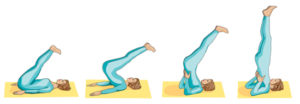
Birch with support on the wall
Features of the performance of Birch with support on the wall:
- The blanket must be placed 60 centimeters from the wall. Lie on your back so that your shoulders are located 3 centimeters from the edge of the blanket. In this case, the head should be on the floor.
- Bend your knees, stretch your arms along the body, palms up.
- Press the back of your head to the floor, and your arms and shoulders to the blanket. As you exhale, move your legs behind your head and try to touch the walls with your toes.
- Bend your elbows and place your palms under the lower back. The fingers should be facing up.
- Hold the pose for a while while feeling comfortable.
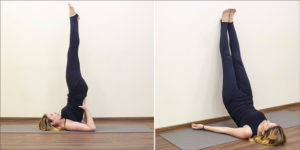
Birch with a chair
To perform this version of the Birch exercise, in addition to a chair, you will need a roller. It should be placed on the floor, parallel to the legs of the chair.
- First, sit on a chair with your chest to his back, wrapping your arms around it.
- Take turns throwing your legs over the back of the chair and slowly lower your arms, moving your buttocks to the back.
- Lower your back to the level of the seat and rest your elbows on it. Then gently move your buttocks to the front edge of the seat, holding onto the backrest. Lower your shoulders onto the bolster and carefully move out of the seat.
- Put your head on the floor. Grab the back legs of the chair with your hands and straighten your legs.
- Hold in this position for a while.
- Grasp the sides of the chair with your hands (as close to the back of the chair as possible). Bend your knees and place your feet on the upper back. The buttocks should be at the front edge of the seat.
- Straighten your legs alternately, supporting the body with your hands. Then raise the chest just as high as possible. Stay in position for a while.
- On exhalation, lower your feet to the back of the chair and slide smoothly off the seat.
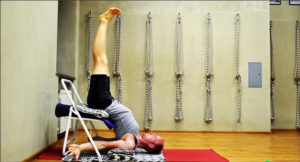
Recommendations for the exercise
To hone the technique, it will be useful to "look" at yourself from the side while performing it. You can ask someone close to take a photo, and then compare the position of the body with what is shown in the photo. This will provide an opportunity to draw up a visual representation of the ideal position.
To get the most useful and effective result from performing the Berezka exercise, you should adhere to the following recommendations:
What time of day to perform birch
It is important to note that the result of the practice of the Berezka exercise directly depends on the regularity of its implementation: the more often, the better. For maximum benefit, the shoulderstand should be included in your daily routine and performed every day.
The best time to exercise is in the morning, however, evening yoga classes are also welcome.
How much do you need to do
A birch tree has a number of useful properties, but you can feel them all on yourself only after a certain duration of execution. Beginners to practice Birch will benefit from starting from one minute with a gradual increase in time. Optimal for professionals is 30 minutes.
However, it is important to remember that the use of a stand on the shoulder blades is determined not only by its duration - much also depends on the correct execution of Birch.Initially, you should choose and correctly develop the most suitable technique of the stand on the shoulder blades, and then focus on the duration of the execution. After all, a long stay in the wrong posture can cause serious harm to the body and aggravate existing diseases.
Reps and sets
When performing both Berezka exercises and other yoga poses, it is very important to learn to feel your body and in no case exceed its natural capabilities, depending on physical fitness. It is then that the Birch pose will bring maximum benefit.
The main thing is to be sensitive to your body, to perceive the appearance or intensification of a feeling of discomfort as signals to which you need to react wisely.
That is why there are no strict recommendations regarding the repetitions of the exercise in the exercise. A person himself must feel and understand what his own body wants. If there is such a need, you can do several more asana approaches. However, it is not recommended to do more than 4 repetitions of Birch at a time: this can harm the muscles.
It is also worth noting that the Berezka exercise also has age restrictions.
It is best to start practice at a young age, when the body is most flexible and ready for stress. People in old age need to consult a doctor, since there are a number of diseases in which the performance of Berezka is categorically contraindicated.
Possible difficulties and common mistakes
When performing the exercise Birch, difficulties may arise due to physical unpreparedness. In this case, Birch can be lightened: the most ordinary chair is used for this. It must be placed behind the head and legs thrown back. The toes should touch the seat, after which you can smoothly align the body and get into a pose.
There is no need to strive to stand in the Birch as long as possible: the body must get used to its position. You should start with 30 seconds, gradually increasing the duration to 3 minutes. It is important to remember that it is necessary to increase the exercise time only when the body has adapted to the position as much as possible and the person does not feel discomfort.
It should also be remembered that getting into the Birch stance without first warming up can cause serious harm to the muscles and internal organs of the body.
There are several rules to help you perform the exercise correctly and effectively:
- performing Birch, you need to try to relax as much as possible;
- the feeling of discomfort is unacceptable - this is a sign that the stand is being performed incorrectly or for too long;
- during the stance, do not turn your head or neck, this may result in injury.
It is very important to get out of the Berezka correctly to the starting position. Many consider this Sarvangasana to be a fairly easy and safe exercise and neglect the recommendations for the correct completion of the stance, which subsequently leads to injuries and health problems.
At the end of the exercise, you do not need to "collapse" to the floor or jump up suddenly. To get out of Berezka, you must slowly lower your legs behind your head, and then gently put them on the floor. After that, it is recommended to lie down quietly for a while.
For optimal output and balancing the load on the spine in yoga, it is recommended to perform the "fish pose", or Matsiasana, immediately after Berezka. These two exercises create a kind of tandem that effectively works with myxedema, thyrotoxicosis and is used before the use of hormonal drugs shown for these diseases.
The exercise is performed from the same starting position as in Berezka: lying on your back.
From the belt, you need to perform the maximum backward bend, at which the pelvis and elbows will be the support. Legs need to be extended freely, in the advanced version you can fold into the "lotus position", and you can grab your feet with your hands.The shoulders are pulled back as much as possible. The back of the head should not touch the floor. The effect is achieved by stretching the throat. In this case, there is an intense saturation of the thyroid gland with blood, the release of hormones of this gland from the follicles. Signs of correct exercise will be an increase in body tremors and fever. The time in the pose is from 1 to 2 minutes, also with a gradual build-up.
Contraindications for performing birch trees
Despite all the benefits, the Berezka exercise has a number of contraindications, in which its implementation can cause harm to health:
- neck and spine injuries;
- high blood pressure;
- hypertension;
- diseases of the auricle;
- with a high degree of enlargement of the thyroid gland, liver or spleen;
- heart disease and weak blood vessels;
- thrombosis or blood contamination;
- cervical spondylosis or prolapse of the intervertebral disc.
Exercise Birch is also not recommended to be performed after eating or drinking alcohol, as well as women during menstruation. The exercise can be difficult for overweight people: in this case, you need to put a blanket under your shoulders, and use a wall to enter the asana.
There are different opinions on performing the stance during pregnancy. Some believe that the practice of the Birch exercise will only benefit a pregnant woman,
others are sure that training can disrupt the current processes in the body and harm the health of mom and baby.
Performing inverted yoga asanas, as well as their lighter versions, has a positive effect on the course of pregnancy. However, if the pose was not mastered early, or if its execution causes discomfort and discomfort, you should not persist.
How can you replace the exercise birch
If performing Berezka is contraindicated, you should not despair - this exercise has several worthy analogues, in which almost all of the same muscles are involved. However, before you include them in your practice, you must carefully read the execution techniques and possible contraindications.
Halasana (plow pose) is an asana with legs thrown behind the head.
Such an analogue of the Berezka exercise has a number of properties useful for the body: the plow posture helps to stretch the back and neck, develop mobility of the spine, has a positive effect on the thyroid gland, and is also indicated for lowering the internal organs. Thanks to its implementation, the muscles of the abdomen, thighs, and pelvic region are strengthened. Exercise can remove excess body fat, speed up metabolism and improve appetite.
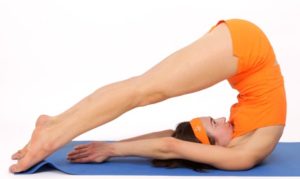
Karnapidasana (Ears to Knees pose)
This is a kind of continuation of Berezka, if you bring your legs from a straight position behind your head. During this exercise, the knees squeeze the ears, drowning out external noises and drawing the person's attention to their inner world.
Exercise helps to increase blood circulation in the spine, relieves back pain, is a good prevention of osteochondrosis and flatulence, and normalizes the work of the cardiovascular system. It is considered one of the most difficult inverted postures of Hatha Yoga.
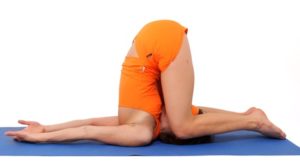
Niralamba-Sarvangsana (unsupported shoulder stand)
This exercise is considered the most difficult variation of the Birch exercise.
Niralamba-Sarvangsana tones and stimulates, benefits from stretching the spine. When done daily, you can improve the blood supply to the brain, develop a sense of balance in the body, strengthen the muscles of the neck, abs and back, get rid of toxins and toxins in the body. The exercise is especially recommended for people with neuralgia, cardiac arrhythmias, cystitis, stomach ulcers, and hypertension.
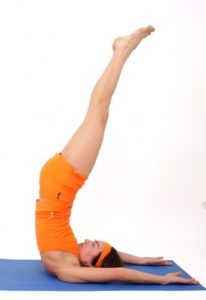
Conclusion
The benefits and harms of Berezka exercise for the human body continue to be actively studied by specialists to this day. Many useful properties and effects of this asana have been discovered: Birch is able to improve both our brain activity and restore physical health.However, it is important to take into account that, despite all the advantages, the stand on the shoulder blades has a large list of contraindications that must be taken into account before introducing the asana into your practice.
Supplement about the properties and techniques of performing the Berezka exercise - in the video:

